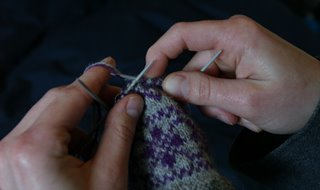- This is how I hold the yarn: Continental-style, with both strands coming over the same finger. Note that I have the yarns twisted a bit up near my finger. That's not an accident; I found that it helped me when I started knitting. Knittinghelp.com's video shows the strands on different fingers. My hands are simply not big enough to hold a strand of yarn above my knitting with any finger other than the index finger.

- If I want to make a stitch in grey (my main colour), I select the yarn as follows: I put my needle over the grey yarn and under the purple yarn, then make a stitch. This is where the little twist I put into the yarn helps: the yarns behave more as a cohesive entity (especially with this grabby Nordic yarn), so I can just put my needle into the little void between the two yarns. Try this out for yourself, as I'm trying to describe a subtle feel to the yarn created by the twist. Obviously, it may work better for you without the twist.

Then, I continue the stitch as a normal Continential-style stitch, by bringing the yarn I've selected through the loop on the left-hand needle.
- If I want to make a stitch in purple (my contrast colour), I select the yarn as follows: I put my needle over both yarns, pick up the purple strand, and finish the stitch as usual. Here again I found the little twist helpful, as it makes the purple yarn "stand up" vertically above the grey near my finger. At the point where it "stands up", I can just easily grab the purple without touching the grey yarn.

I hope this helps someone out. Using this technique, I found stranded knitting to be rather intuitive and easy (note that until I worked out my tension, I did a lot of dropping and picking up of the yarn strands before I hit my stride). Actually, even with the chart reading, I believe that I (Chialea) knit faster with two strands than Krista does normally. If you haven't tried out Continental-style knitting yet, I'd reccomend it; try Knittinghelp.com's Continental knitting tutorial.




No comments:
Post a Comment